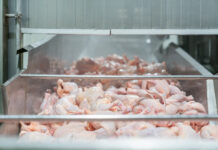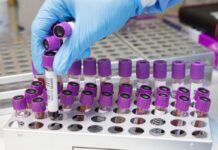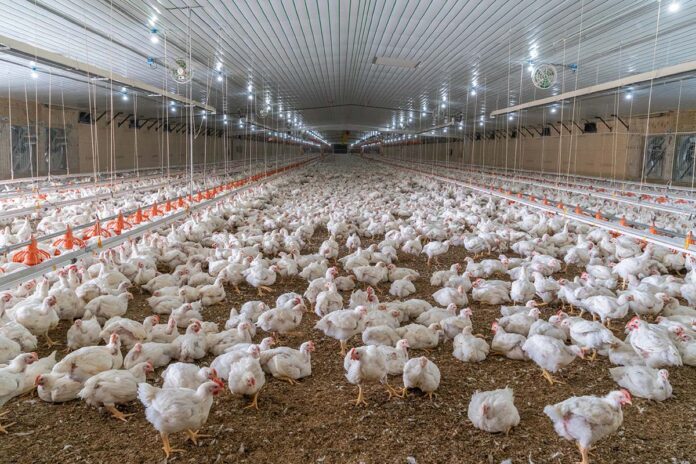
One of the purposes of preheating a broiler house is to ensure the litter is properly dried prior to chick placement. Research has shown that the higher the litter moisture level, the higher the level of ammonia production, potential for bacterial growth, paw damage, and likelihood the chicks may be chilled by sitting on cool, damp litter. Furthermore, high litter moisture levels will tend to reduce the effective life of most ammonia control products, which in turn can lead to excessive ammonia levels at the beginning of the flock when the birds are most susceptible to the adverse effects of ammonia.
Ideally, excess moisture deposited into the litter by a previous flock would have been removed prior to chick placement by removing cake, working the litter (possibly windrowing), as well as through proper ventilation. The problem is during the cooler times of the year, when it becomes very difficult to dry the litter between flocks due to low outside temperatures and the desire not to use supplemental heat. The more a house is ventilated, the lower the house temperature will become, and the more difficult it is to remove moisture from the litter.
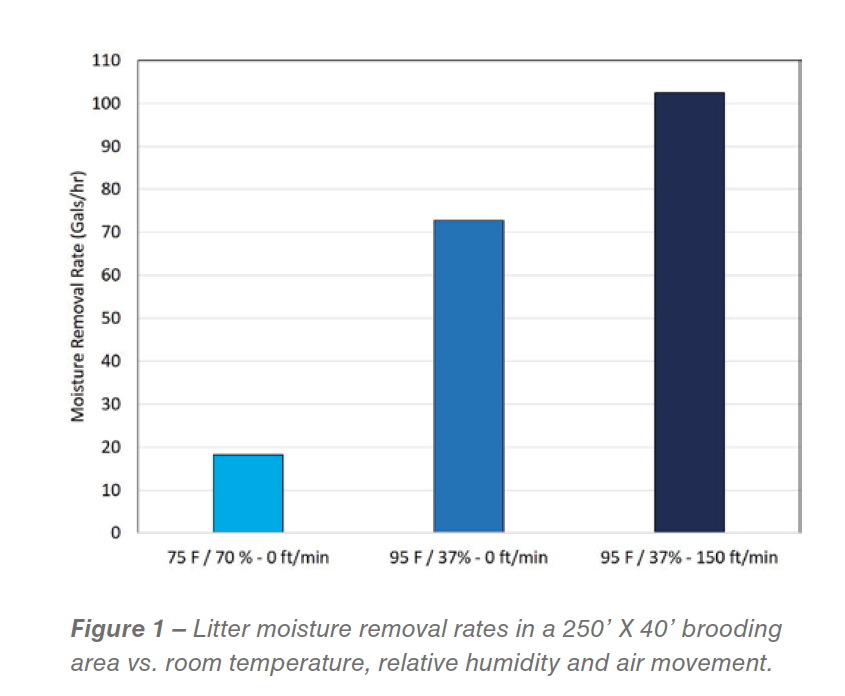
After all, it is difficult to dry anything with cold, damp air. Conversely, if ventilation is kept a minimum, the house may be warmer, but humidity levels will tend to become excessive, which in turn will reduce litter moisture removal. As a result, it often becomes crucial that a house is sufficiently preheated to insure a proper litter moisture of approximately 15–20% has been achieved prior to chick placement.
It is generally recommended that preheating begins approximately 48 hours prior to chick placement. There are primarily a couple of schools of thought when it comes to preheating. The first involves, preheating the house to 70 or 80 °F for the first 24 hours and then increase house temperature to 90–95 °F 24 hours prior to chick placement. The second, is to simply preheat the house to 90–95 °F for the 48 hours prior to chick placement. Which is better? To some extent it depends on how great of a need there is to remove moisture from the litter.
Litter moisture removal is determined primarily by house temperature, relative humidity and the amount of air movement over the litter. The higher the preheating temperature, the lower the relative humidity will be and the greater the amount of moisture pulled from the litter. Increase the amount of air moving over the litter, and the rate at which moisture is removed from the litter will be further increased.
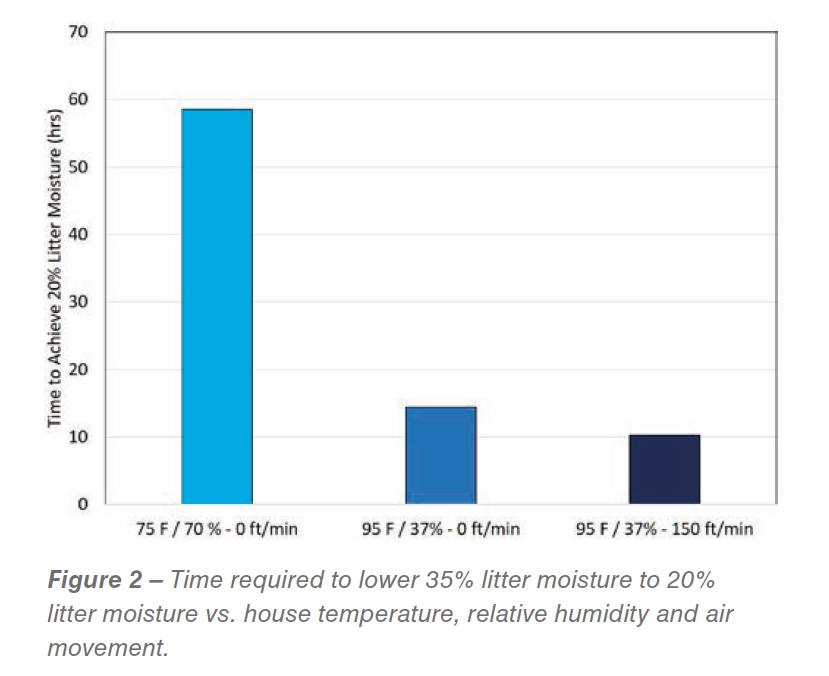
For example, let’s say we have a 40’x250’ brooding area with built-up litter being preheated to 75 °F and the relative humidity is 70%. Research has found that if the litter has a moisture content of 35% (very damp), roughly 18 gallons of water will evaporate from the top two inches of the litter each hour (Figure 1). If we increase the temperature to 95 °F, the relative humidity of the air in the house will decrease to approximately 37%. This is because for every 20 °F we increase the temperature of air, the relative humidity will be cut roughly in half due the increased moisture-holding capacity of warm air. Since the air next to the litter is now much warmer and drier, the rate at which water will evaporate from the litter will increase roughly four-fold to 73 gals/hour. If air speed at floor level increased to 150 ft/min, the litter moisture removal rate would increase nearly six-fold to approximately 100 gallons per hour.
What would happen to litter moisture levels in this scenario? There are approximately 1,970 gallons of moisture held by the top two inches of litter in a 40’x250’ a brooding area when the litter moisture is 35%. If the litter moisture removal rate of 100 gallons per hour (95 °F/37% Rh) could be maintained for just 10 hours, the litter moisture content could be decrease to 20%… essentially ideal. Now in reality, over the course of the 10 hours, as the litter moisture content decreases, the rate at which water would be removed from the litter would also decrease; therefore it would likely take much longer to decrease litter moisture levels to 20%, possibly twice as long.
But the fact remains: preheating to a temperature around 90 °F will result in dramatically higher litter moisture removal rates and in turn drier litter than using a staged preheating program where the lower temperatures and higher levels of humidity would tend to result in a dramatically less moisture being removed from the litter each hour (Figure 2).
It is very important to keep in mind that as moisture is removed from the litter, the relative humidity of the air in the brooding area will increase. If minimum ventilation fans are not operated during preheating or operated at a rate where an acceptable level of relative humidity is not maintained, then the rate at which moisture is removed from the litter will decrease over time.
For instance, whereas at 95 °F, 73 gallons of moisture would be removed from the litter each hour in the aforementioned example if a relative humidity of 37% is maintained, if the humidity in the house were to increase to 70%, because the minimum ventilation fans were not operating enough, the litter moisture removal rate would decrease to 35 gallons per hour, a reduction of roughly 50% (Figure 3).

Litter moisture removal is a two-step process. Transfer the moisture from the litter into the air next to the litter, then transfer the moisture from the air in the house to the air outside the house. The downside of this of course is that when we remove moist air from a house, we will need to replace it with cold outside air which will need to be heated. But in the end, it is typically better to obtain proper litter conditions prior to chick placement than to have to worry about all the negative aspects of having damp litter after the chicks arrive.
Though the litter moisture removal rates provided above are based on numerous experiments conducted by The Department of Agriculture and Fisheries, Queensland, Australia, it must be noted that actual litter moisture removal rates could vary significantly. This is because the rate at which moisture is removed from the litter also depends on factors such as litter type, depth, age, type of heating system, level of air movement, etc. Moisture removal rates can also change over time as environmental conditions and litter moisture levels change during the drying process. But the fact remains, higher air temperatures will always result in dramatically higher litter moisture removal rates. So though it may be tempting to reduce preheating temperatures, keep in mind that a ten-degree lower preheating temperature may not seem like much, but could easily result in a 50% decrease in litter moisture removal during the preheating process.
In the end if you want to remove moisture from the litter it takes three things: heat, relatively dry air, and some air movement. The warmer the air, the lower the humidity, the greater the amount of air movement, and the faster moisture will be removed from the litter. If you are able to throughly dry your litter between flocks, then using a two stage preheating program could be the right choice. If you are not, and the litter is damper than you would ideally like, a preheating temperature in the 90’s is probably the best option to quickly pull excess moisture from the litter. But do not forget, it does little good to remove the moisture from the litter if you do not then remove it from the house.
From Poultry Housing tips, Volume 33, Number 1 – The University of Georgia, College of Agricultural and Environmental Science – Cooperative Extension
Mark Dunlop, Principal Environmental Researcher Dept. of Ag. and Fisheries, Qld, Aust.
Michael Czarick, Extension Engineer, and Brian Fairchild, Extension Poultry Scientist College of Agricultural and Environmental Sciences, Cooperative Extension, University of Georgia


